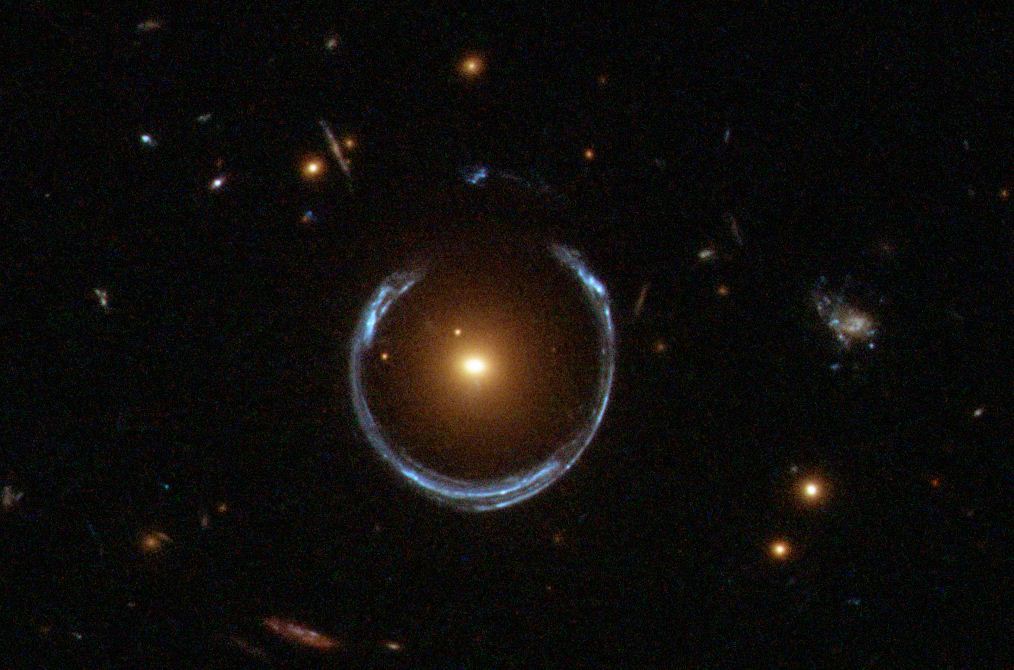Let's Bend light
 Akshay loves stargazing. So much so in his free time he browses through different images of stars and galaxy taken by telescopes, on the Internet. One day he came across this weird photo. Soon he found out that the blue ring in the picture is actually a galaxy and was formed due to the distortion in the path of light coming from the blue galaxy. This effect is known as gravitational lensing and it happens because a gravitational field of a massive object can bend a ray of light. Let's think of this happening due to a change in the effective refractive index of the medium given by
where
is the distance of the point of consideration from the center of the mass of the massive body. Considering a spherical body, find the deviation of the ray from the original path as it grazes the object.
Akshay loves stargazing. So much so in his free time he browses through different images of stars and galaxy taken by telescopes, on the Internet. One day he came across this weird photo. Soon he found out that the blue ring in the picture is actually a galaxy and was formed due to the distortion in the path of light coming from the blue galaxy. This effect is known as gravitational lensing and it happens because a gravitational field of a massive object can bend a ray of light. Let's think of this happening due to a change in the effective refractive index of the medium given by
where
is the distance of the point of consideration from the center of the mass of the massive body. Considering a spherical body, find the deviation of the ray from the original path as it grazes the object.
Your answer will be of the form , where is the radius of object. Input your answer as .
Details and Assumptions:
- While calculating you can ignore a product of two differentials.
- The above-mentioned effect actually happens due to distortion in space.
The answer is 4.
This section requires Javascript.
You are seeing this because something didn't load right. We suggest you, (a) try
refreshing the page, (b) enabling javascript if it is disabled on your browser and,
finally, (c)
loading the
non-javascript version of this page
. We're sorry about the hassle.
Let us consider two arcs concentric with the centre of the planet at a distance r and r + d r . Let the light be incident at angle θ at the surface at r and leave r + d r at an angle θ + d θ
As h < < R and the light ray initially was tangent to the surface, the marked angle can be assumed to θ . Then from the Snell's law,
n ( r ) sin ( θ ) = n ( r + d r ) sin ( θ + d θ )
Now ( r + d r ) − ( r ) n ( r + d r ) − n ( r ) = d r d n . Which gives n ( r + d r ) = n ( r ) + d r d n d r . Replacing in the above equation and using sin ( A + B ) = sin A cos B + cos B sin A . We get,
n ( r ) s i n ( θ ) = ( n ( r ) + d r d n d r ) ( sin θ cos d θ + cos θ sin d θ )
On simplification we get,
− d r d n tan θ = n ( r ) d r d θ .
Now d r d n = − r 2 c 2 2 G M . Also, ( 1 + r c 2 2 G M ) d r d θ ≈ d r d θ As the object is massive. Replacing all of this in the original equation we get
d θ = c 2 2 G M ( r 2 tan θ d r ) .
Now from the diagram we can see that r 2 = ( h + R ) 2 + x 2 . And tan θ = x R + h . As the light ray just grazes the planet, h < < R → R + h ≈ R . So r 2 = R 2 + x 2 → d r = x 2 + R 2 x d x and tan θ = x R . Replacing all of this in the original equation and integrating within proper limits we get
∫ 0 θ 0 d θ = c 2 2 G M R ∫ − ∞ ∞ ( x 2 + R 2 ) 2 3 d x
θ 0 = R c 2 4 G M